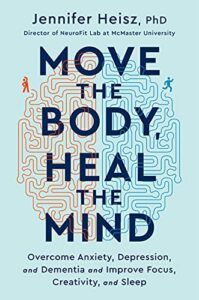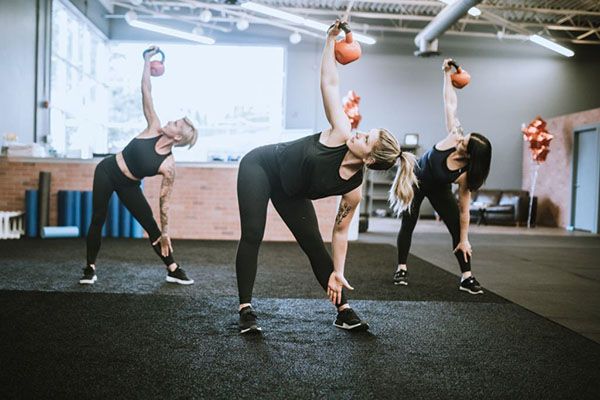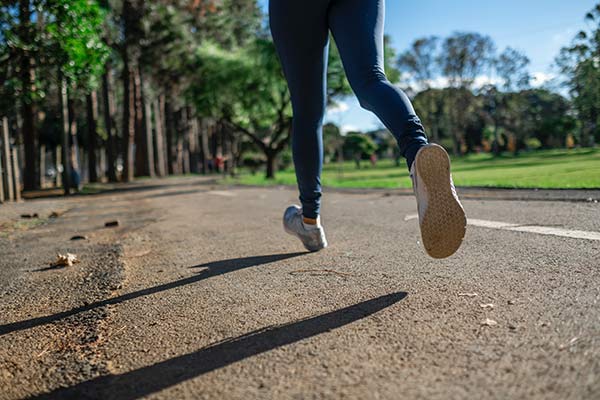Welcome back to the Healing Pain Podcast with Jennifer Heisz, Ph.D.
As always, I am delighted and honored to be spending this time with you. I recorded an episode on embodied cognition and the body’s role in thought with Psychologist Rebecca Fincher-Kiefer. In that episode, we discuss the importance of using the body as a therapeutic tool for helping modulate difficult emotions or thoughts that people may encounter from chronic pain or other various chronic health conditions. As physical therapists, using the body as a tool for healing from pain or other conditions, whether it’s physical or mental, is a big part of what we do.
In this episode, we’re going to go deeper into how to use the body, including how to use exercise and physical activity to improve pain as well as mental wellbeing with Dr. Jennifer Heisz. She is an expert in brain health. She’s an Associate Professor and Canada research chair in Brain Health and Aging in the Department of Kinesiology at McMaster University. She directs the NeuroFitLab, which has attracted over $1 million to support her research program on the effects of exercise and physical activity on brain health.
Her award-winning research examines the effects of physical activity on brain function to promote mental health and wellbeing in young adults, older adults and individuals with Alzheimer’s disease. She has a new book coming out called Move The Body, Heal The Mind, which examines the latest research on how exercise can help you overcome anxiety, depression and dementia, improve focus and creativity, sleep better and even improve chronic pain. Without further ado, let’s begin with Dr. Jennifer Heisz and learn about how we can use exercise and physical activity to improve brain health.
—
Watch the episode here
Listen to the podcast here
Subscribe: iTunes | Android | RSS
How Exercise Can Improve Pain, Mental Wellbeing, And Brain Health With Jennifer Heisz, Ph.D.
Dr. Jennifer, thanks for joining me on the show.
It’s my pleasure.
We’re excited to talk to you because we love talking about movement and also the brain. You happen to have authored a great book on how moving the body heals the mind and the brain. We’re excited to hear all about that. As a physiotherapist, this is so exciting for us. Tell us how you became interested in that intersection between movement and studying the brain and exercise.
It happened a while ago when I was in graduate school studying Fundamental Neuroscience. How does the brain represent who we are? How does it form memories and create them? It became clear that something wasn’t going right with my brain. I was having pretty severe anxiety and wasn’t getting any help that I wanted from the medical community.
On a whim, I borrowed my friend’s rusty old road bike and was amazed that the movement soothed my mind. It quieted my mind. From that point forward, the movement became a central focus for both my personal life but also my professional life. I shifted my focus of research to not only study fundamental neuroscience but also how exercise as a stimulus evokes all these fascinating things in the brain.
For some reason, there’s still this what I consider a stigma attached to exercise. It’s like, “Are you going to exercise to have stronger or bigger muscles or to be more flexible and look good?” That’s the end of the conversation almost. I love people like you who would come in like, “Let’s take the conversation much deeper for people who are struggling with physical and mental health challenges but even us as professionals.”
Even as professionals, we go to school and learn about all these topics and mechanisms but we haven’t quite learned how to have a conversation in a way that the average person is like, “Exercise is much more than becoming sweaty.” How do you start to weave this in? You have research subjects but you must be talking to them one-on-one about the importance of exercise.
One thing that sets my book and my approach apart is that it does take this compassionate approach to exercise, not just for the body but also for the mind. When we start talking to people who are struggling with issues, whether it’s anxiety or depression, exercise is almost the last thing they want to do. In a research study that we conducted right at the beginning of the pandemic, we surveyed over 1,600 people. It was interesting because there was a shift in why they wanted to exercise. It was getting away from looking good and moving towards feeling good.
There was a bit of a catch-22. We call it a mental health paradox because people wanted to work out for their mental health but their anxiety and stress were getting in the way. They lack motivation, which is a symptom of depression. We need to approach movement differently when treating people with mental health issues or who are struggling at the moment. One of the mantras people should adopt is, “Some is better than none and consistency is key.” It’s less away from intensity and more towards consistency.

People have heard this message before, “Exercise is good for you. You should exercise.” The American College of Sports Medicine guidelines, which are similar worldwide, about maintaining at least five hours of exercise a week for your health. Yet it can be hard for people to begin an exercise program. Why is it so hard for people to get that stimulus to begin?
When you look at that number, the ACSM put that number, it’s big. If you’re starting at zero, that’s quite intimidating. We did a review for the ACSM’s Health & Fitness Journal and it turns out, you can get by with a lot less for your mental health. What we could do is to get people moving for their mental health. They will build up this feel-good feeling around exercise, get into the habit and then we can layer on what they need to do for their physical health.
Should we have a separate set of guidelines for mental health and exercise specifically?
Yes. It seems to be much less than the 150 minutes of moderate to vigorous activity or the 75 minutes of vigorous activity per week. This is something that we are on a mission to do. It’s to develop these exercise guidelines for mental health or brain health. In the NeuroFitLab, we’re building up the evidence to help generate these.
That’s great news for people because five hours seem overwhelming if you have a busy life, as all of us do, and if you have a chronic health condition. In the context of our show, we’re talking about chronic pain but many people have other types of health conditions where they say, “I can’t do five hours of exercise. Where does that leave me?”
There are two important conversations to have. One is that the brain wants to conserve energy. It essentially makes us lazy. The brain evolved during a time when we had to expend a lot of energy to hunt and gather our food. That relic is still the brain. In our modern-day society, we don’t have to do that. The brain wants to prevent us from expending any extra energy. Voluntary exercise is seen as an extravagant expense. It goes out of its way to talk you out of moving, “You’re too tired. Do you even have time to exercise?” Its rebuttals are relentless.
First off, we have to realize that we are up against this inertia that’s set up in the brain. A super simple way to get around that is by making a plan. Physiotherapists or physical therapists do this all the time. They create a plan for their patients or clients where it denotes when they should exercise and what exactly they should do. Block it off in the calendar and treat those as important meetings as any other meeting you have. That’s one of my go-to’s to help fit it in despite my busy schedule.
That helps people get over that initial biological inertia. Especially when it comes to people who are suffering from chronic conditions, there’s this psychological inertia too. There’s this fear and that fear can prevent them from moving in the way that they should. I was seeing a physiotherapist during my training. I’ve been training for a triathlon. One thing that he mentioned to me was that it’s this fear that people can’t do it, they’re not athletes or it will hurt them, blocking a lot of people from getting the help that they need.
Fear always is a factor, especially with chronic pain. Even in starting an exercise program, movements can seem scary. The amount of exercise or the intensity can seem scary. A gym environment can seem scary to people. You mentioned physios before. Exercise is part of what we do. It’s part of kinesiologists, personal trainers and lots of other health and wellness professionals. When I look at the research on mental health, which you know well, there’s almost overwhelming research on exercise for mental health, specifically anxiety, depression and even PTSD.

The evidence is starting to accumulate. It’s profound. The effects of exercise for certain depression conditions can be on par or even better than antidepressant medications. Exercise for anxiety treatment can be beneficial. It can even be an exposure therapy for people who have anxiety sensitivity. In a way, we can expose them to somatic feelings of anxiety-like a racing chest or heart, difficulty breathing and lack of focus. These are symptoms of anxiety that can exacerbate it into a panic attack.
Those same symptoms are present in exercise. When we’re exercising vigorously, our heart races, it’s hard to breathe. Sometimes, it’s difficult to stay focused and concentrate. Exposing people to those feelings in their bodies can help them cope and tolerate those feelings when they experience them outside of the exercise setting. It’s when they experience them in an anxiety setting before they give a presentation, for example.
Exercise can be a form of exposure, which we know but you were saying specifically in the context of anxiety or what we consider panic attacks. A panic attack often seems like heart racing, shortness of breath, sweaty palms, sweaty temples and very similar symptoms that are going on.
People with this anxiety sensitivity may not have anxiety or a full-blown diagnosis but they could have this sensitivity to the symptoms. It’s very difficult to get these individuals to exercise. They don’t want to and if they do, they try to avoid any vigorous exercise even though it’s the medicine that they need in small doses. In my book, I talk about using a more gradual approach. The first part is the Fear Buster workout. I have people walk at a brisk pace. This low to moderate form of exercise has been shown to increase Neuropeptide Y, which is a resiliency factor in the brain.
As you mentioned with PTSD, people who have more neuropeptide Y or NPY are protected from developing PTSD. They may be exposed to the same trauma but increasing neuropeptide Y or having greater reserves of it protects them. We can build up neuropeptide Y with light to moderate exercise. I have this Fear Buster workout where they briskly walk to get the neuropeptide Y reserves up. Once they’re feeling resilient, they go for a quick burst at high intensity. This exposes them to those feelings that they fear the most.
It’s a brisk walk, which can be 5 or 10 minutes or so and then a burst of intense activity. You’ve all heard of High-Intensity Interval Training. How long of a burst do we need for that group? How many minutes?
It can be ten seconds. All they need to do is elevate the heart rate to the point that it makes them feel uncomfortable. Start with a few seconds and then gradually add several more bouts. It’s exposure therapy. It habituates them to the symptoms.
All the PTs will try that because now they’re thinking, “We could do this on a treadmill, a bike or maybe in the gym with basic exercise.” The reason I love that is that there are connections between pain-related anxiety or anxiety and pain that are useful. It’s a big chapter in your book. Should we be at the point where the first intervention for things like mild to moderate depression should always include exercise instead of anti-depressant medications or even Cognitive Behavioral Therapy? CBT is looked upon as the gold standard but before the research, it is interesting when you start to look at exercise.
Exercise needs to be part of the initial conversation, especially nowadays when most people are experiencing symptoms of depression that are brought on by the chronic stress of the pandemic and life in general. It’s important to have this as part of the conversation. It’s starting to change a little bit since the onset of the pandemic but prior to that, it was left out of the conversation. You would show up at your doctor’s office and they would hand you a prescription for antidepressants. The problem with that is that antidepressants don’t work for 1/3 of people who take them.

Imagine going to the doctor, finally getting the courage to admit that you’re not feeling well, getting a drug, reluctantly taking it and it doesn’t work, being so confused and feeling so helpless. I devote a lot of time in the book to talking about that because it’s an important message that a lot of people don’t realize. These individuals who have drug-resistant depression are the ones who could benefit the most from exercise. For them, exercise is the medicine they need far more than any antidepressants.
I’m wondering how the mental health community has picked up on your work because their job is mostly sedentary. Even though they’re counseling on healthy behaviors, it’s always interesting to me that they’re counseling on healthy behaviors in the context of sedentary behavior. That’s true for chronic pain and depression. I’m wondering how the mental health community is starting to say, “How might Dr. Jennifer’s research help inform or change what I do as a mental health professional?”
We’re all on the same team. You mentioned CBT. There’s great research coming out about how exercise can help to bootstrap it or speed it up because it does take a long time for CBT to start working. For a lot of people, it takes too much time. They don’t have the patience to get out for it to be beneficial. They see the benefit there. A lot of therapists talk about a healthy lifestyle, which includes getting enough exercise, eating well and sleeping well.
These all are hand-in-hand with healthy mental health. The community is very open to this. A lot of social workers or psychotherapists talk about this and managing lifestyle. They’re there to help coach you through that. A lot of them don’t have the skills necessary to prescribe exercise and this could be a beautiful marriage between a physical therapist and a psychotherapist. Imagine you go to a clinic that offers both and they work in tandem to get you moving more.
More and more PTs are interested in mental and behavioral health, which is great. It’s interesting because I always think, “The primary aim or one of the aims of mental health is to improve cognitive function.” We know that exercise improves cognitive function. It is a nice marriage. How does exercise help with our cognitive function as we age? The aging aspect is something that is of interest to a lot of people.
We have done quite a lot of work on this. One of my favorite studies is we combined or contrasted genetic risk for dementia versus physical inactivity and found that physical inactivity contributes to dementia risk as much as your genetics. I have this thing I like to say, “You can’t change your genes but you can change your lifestyle.” It underscores the importance of movement in protecting the brain. We have also done a study where we looked at interval walking with seniors and compared it to regular walking or stretching.
What we found was interval walking, in particular, had an incredible boost on memory performance for seniors who were previously sedentary. What does interval walking look like? You go out for your regular walk and pick up the pace to the point where it’s difficult to have a conversation. It’s the talk test. They repeat that over and over about five times for approximately a 20-minute to 30-minute workout. Seniors love that because a lot of seniors like to walk. I often say, “Pick up the pace between light posts or add a few hills into your loop.” It’s relative. They’re not going to go out for a full-on sprint but these bursts of higher activity help generate more lactate in the muscles.
This is some cool research out around lactate. We often think of lactate as this villain or this bad thing we want to get rid of but it turns out lactate is one of the greatest promoters of neuroplasticity in the brain. It moves from the muscles to the brain and stimulates growth factors like brain-derived neurotrophic factor, vascular endothelial growth factor and all these growth factors that help support the growth and function of the brain cells. In particular, the hippocampus, which is a key region for memory function and is also what is most damaged by Alzheimer’s disease.
That’s a cool feedback loop we have. I try to figure that out from an evolutionary perspective. Movement has been with us through the ages. When there are bouts of higher intensity or increased intensity exercise, your brain is saying, “There’s something going on here that I should be paying attention to.” Whatever happened, that lactate is a signal to lay down new memory neuroplasticity and new learning, which is so interesting from the perspective of lots of different things.

Are you familiar with orienteering?
Yes.
I have an expert orienteer in my lab. Coincidentally, she’s a grad student and this is her project. She’s having people do orienteering bursts of activity while they spatially navigate, which is essentially what our ancestors did to hunt and gather food. We think that this will be a beneficial way to boost memory in older adults.
That population of older adults is so left out of the conversation oftentimes with exercise until maybe they’re injured and then they wind up in the physical rehab setting. It’s talking to older adults, not only about their physical health and mental health but also their brains. Preserving cognitive function should be at the top of our list with that population.
They’re terrified of getting dementia. Unfortunately, there’s no cure. There’s no pill that they can take. They’re constantly seeking ways to prevent it. Older adults are behind this. If you tell them it will prevent dementia and there’s strong evidence for this, they will start moving. There was a systematic review that said, “Resistance exercise is especially important for older adults to improve their cognition.” If you think about it, it stimulates the muscles but not only that. It strengthens the muscles and improves mobility and then they can move more, walk more, walk easier and take the stairs. It is the foundation for layering on top of the intensity that they need to get the lactate up.
Another area in your book is creativity. I did a three-hour online workshop on how meditation can improve creativity. I do a lot of writing. I’m interested in how I can increase my creativity. I did this three-hour workshop. I’ve been meditating for decades. I didn’t have much of a change at all. Coincidentally, when that whole workshop was over, I went out for a walk down to the Hudson River. I live in New York City.
All of a sudden, thoughts started moving rapidly. When I wrote my first book, what I did when I used to get that writer’s fatigue was I went for a walk. I would feel refreshed and come back. When I saw your book come over my email and I started reading the creativity part, I was like, “What’s the connection between movement and creativity?” I’m a natural mover and movement tends to increase my creativity levels more than anything that I’ve come across.
I hear you on the meditation too. I’ve been trying for years. I do find it helps but it also is a nice complement to movement and exercise. The mindfulness perspective and incorporating that in with your movements like attending to your breath and the body helps make the movement a mindful meditation but you’re actually moving, so it’s a little bit easier. The creativity piece is so interesting because it can be only ten minutes of a self-paced walk and it’s enough to stimulate creativity.
The research is looking at creativity from this cross-training perspective. When we’re writing or doing something intensely, we’re doing one thing. We’re not doing many different things. The brain needs to be flexibly shifting between things. If you’re sitting at your computer writing and you’re stuck, switching the context and going out for a walk is that cross-training that you need to flip the switch so that you have some new ideas and a fresh perspective on what you were writing.

It’s not blood flow because someone said, “You’re increasing blood flow to your brain.” I was like, “I do other activities that increase blood flow.” Lifting weights doesn’t tend to increase my creativity much. For some reason, it’s walk. What you say about changing multiple contexts makes more sense to me.
It is partly blood flow. When we’re sitting for long periods, blood flow decreases. I found that when I was writing my book. I was sitting for long periods. It’s the frequent movement breaks. Every 30 minutes, getting up for a two-minute movement break and could be a walk around the block. It’s switching. Why that works is that the brain’s executive functions have two modes. One mode is inhibitory control. This helps you stay focused, which is important. The other mode is mental flexibility, which you do to switch tasks, navigate your environment and explore different ideas. In this, you need to stimulate to have your creative juices flowing.
You mentioned writing a book. You have a book out. You write for a living as well as research. When you write a book, you tend to sit for more periods. Do you have any a-ha moments like, “This work is so important because I’m writing this book, sitting and noticing that things are changing?” That happened to me when I first started writing it. I was like, “This is fun. I can put things on paper out of my head.” I realized sitting is not a very healthy activity for anyone.
I’ve sat so much that I got stiff. I told you I’m seeing a physiotherapist. This is the irony. I ended up in chronic pain myself. I’m easing back into it. There were tons of a-ha moments. While writing the book, it’s all-consuming. You pour your heart and soul into it in the hopes that it will help others. I hope it does that.
I tell everyone, “Everyone should write a book.” Everyone has at least one book in them. Keep in mind that you’re not going to feel great by the end of the book or at least as far as your body is concerned but it’s a great creative endeavor for people. The last thing I want to touch on is important to the guests of our show because we talk a lot about opioids. The research over 2021 with the pandemic or so is that opioid rates or usage have increased at least in the US by about 20%.
We were starting to decrease those rates and now we see it back up 20%. Where can exercise fit in with addiction, recovery and rehabilitation with that? Opioid is just one pharmaceutical that people have challenges with. Some of these people are going to struggle with addiction for the rest of their life. They may or may not come across exercise as a means to help cope with that.
It’s devastating what’s happening with the opioid crisis up here in Canada too. Prevention is always key. We can target young people and get them moving more. Kids that are more physically active are less likely to experiment with drugs. After the fact, exercise is extremely beneficial for helping to speed up recovery because it’s a lifelong process. Once the brain has a taste of addictive drugs and supernatural levels of dopamine, it never forgets that.
It is a lifelong struggle but the beautiful thing about exercise is that it does increase dopamine as well. It stimulates the reward system and helps to replenish it post-addiction. When we become addicted to drugs, what happens is the level of dopamine in the brain is not healthy. It’s too much for the brain to maintain homeostasis. The brain is so incredibly smart. It removes its dopamine receptors from the reward system. If that drug can’t bind to the receptors, it can’t stimulate pleasure. The problem is now you need that supernatural level of dopamine to stimulate the reward system and feel good.
Natural pleasures and normal things in life like eating and having sex, none of these give the brain pleasure anymore. When you take the drug away, they’re left feeling hopeless. When movement is coupled with that, it can help rebuild those dopamine receptors faster and help crush cravings. Even a single bout of a 30-minute exercise, whether it be cycling, jogging or walking, crushes cravings for about 30 minutes or more afterward. This gives the individual a reprieve from the drug cravings.

Exercise can start to turn the reward system back on because it’s somehow shut down because we’re putting too much of an external reward into the brain or nervous system.
It’s too much. Essentially, the brain seizes and locks down. Exercise helps to open the reward channels back up so that you could start feeling good in life.
Do you have any idea as far as how many minutes it takes once someone starts to move exercise for those rewards systems and the parts of the brain to start to be stimulated?
It’s very individual but it happens fast. Naturally, when you stop using drugs, the reward system will rebuild. From animal model studies, it shows that it takes one week of drug use. This is talking about methamphetamine. With one week of meth use, it took one year for the reward system to recover. Four weeks takes four years. What exercise does is it diminishes that recovery time. That’s a long time. The problem with that long time is that slip-ups and relapses can happen.
The best suggestions are to have exercise available in the rehab facility and have it constantly supervised. Exercise seems to be extremely beneficial where they’re working one-on-one with a personal trainer or coach and having this community of engagement where they have the social support around exercise. It creates this new exercise family that’s different from the unhealthy life that they had before.
There is something out there. It’s called Exercise for Addiction.
In New York, the Odyssey House has a Run for Your Life program, which is amazing. It’s this community run. A lot of former addicts and now athletes have these available. It’s amazing because it does provide not just the neural support in dopamine but also social support, which goes hand-in-hand with movement and therapy for the brain too.
Dr. Jennifer, it has been great speaking with you on the show. We love this topic of moving the body to heal the mind. Let our readers know how they can learn more about you, follow you and learn more about the book.
You can order my book. It’s called Move The Body, Heal The Mind. It’s available on all the online outlets like Amazon, Indigo and Barnes & Noble. I wrote it for you to help you. I hope that it does. If you want to learn more about my research, you can go to NeuroFitLab.com. You can learn about some of the fascinating experiments that we’re doing in my lab.
The website is NeuroFitLab.com. Dr. Jennifer’s book is called Move The Body, Heal The Mind. You can find it on Amazon or any other online retailer. It’s a great book. I encourage you to check it out and share it with your friends and family. I also encourage you to share this episode with your friends and family. You can do that easily by going on social media, taking a screenshot and then tagging me on it. My tag is pretty easy. It’s @DrJoeTatta. When you tag me, I’ll be sure to tag you back. I want to thank Dr. Jennifer for joining us. We will see you.
Important Links
- Rebecca Fincher-Kiefer – Previous episode
- NeuroFitLab
- Move The Body, Heal The Mind
- ACSM’s Health & Fitness Journal
- Odyssey House
- Amazon – Move The Body, Heal The Mind
- Indigo – Move The Body, Heal The Mind
- Barnes & Noble – Move The Body, Heal The Mind
- @DrJoeTatta – Instagram
- @JenniferHeisz – Twitter
- @Dr.JenniferHeisz – Instagram
About Jennifer J. Heisz, Ph.D.
 Jennifer J. Heisz, Ph.D., is an expert in brain health. She is an Associate Professor and Canada Research Chair in Brain Health and Aging in the Department of Kinesiology at McMaster University. She directs the NeuroFit lab, which has attracted over $1 million to support her research program on the effects of exercise for brain health. Dr. Heisz’s award-winning research examines the effects of physical activity on brain function to promote mental health and cognition in young adults, older adults, and individuals with Alzheimer’s disease. Her debut book called Move the Body, Heal the Mind examines the latest research on how exercise can help you overcome anxiety, depression, and dementia and improve focus, creativity, and sleep.
Jennifer J. Heisz, Ph.D., is an expert in brain health. She is an Associate Professor and Canada Research Chair in Brain Health and Aging in the Department of Kinesiology at McMaster University. She directs the NeuroFit lab, which has attracted over $1 million to support her research program on the effects of exercise for brain health. Dr. Heisz’s award-winning research examines the effects of physical activity on brain function to promote mental health and cognition in young adults, older adults, and individuals with Alzheimer’s disease. Her debut book called Move the Body, Heal the Mind examines the latest research on how exercise can help you overcome anxiety, depression, and dementia and improve focus, creativity, and sleep.
